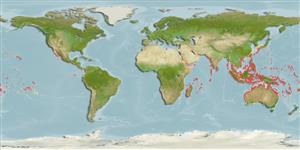Common names from other countries
Environment: milieu / climate zone / depth range / distribution range
Écologie
; profondeur 0 - 20 m (Ref. 348). Tropical
Distribution
Pays | Zones FAO | Écosystèmes | Occurrences | Introductions
Indo-West Pacific: from eastern and southern Africa, to western Polynesia; north to Japan and Hawaii, and south to New Caledonia; Society Islands, eastern Polynesia.
Length at first maturity / Taille / Poids / Âge
Maturity: Lm ? range ? - ? cm Max length : 7.5 cm ShL mâle / non sexé; (Ref. 348); common length : 4.0 cm SL mâle / non sexé; (Ref. 348)
Byssally attached to rocks, on reef flats or to the underside of boulders, on sand and gravel bottoms. May also occur at sub-littoral (Ref. 348) and intertidal depths on soft sediments (Ref. 87907).
Life cycle and mating behavior
Maturité | Reproduction | Frai | Œufs | Fécondité | Larves
Members of the class Bivalvia are mostly gonochoric, some are protandric hermaphrodites. Life cycle: Embryos develop into free-swimming trocophore larvae, succeeded by the bivalve veliger, resembling a miniature clam.
Poutiers, J.M. 1998. (Ref. 348)
Statut dans la liste rouge de l'IUCN (Ref. 130435)
statut CITES (Ref. 108899)
Not Evaluated
Not Evaluated
Menace pour l'homme
Harmless
Utilisations par l'homme
| FishSource |
Outils
Plus d'informations
Taille/ÂgeCroissanceLongueur-poidsLongueur-longueurMorphologieLarvesAbondance
Sources Internet
Estimates based on models
Preferred temperature
(Ref.
115969): 24.6 - 29.3, mean 28.4 (based on 3503 cells).
Vulnérabilité
Low vulnerability (10 of 100).
Catégorie de prix
Unknown.
